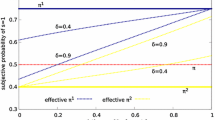Abstract
We consider an economy where a finite set of agents can trade on one of two asset markets. Due to endogenous participation the markets may differ in the liquidity they provide. Traders have idiosyncratic preferences for the markets, e.g.due to differential time preferences for maturity dates of futures contracts. For a broad range of parameters we find that no trade, trade on both markets (individualization) as well as trade on one market only (standardization) is supported by a Nash equilibrium. By contrast, whenever the number of traders becomes large, the evolutionary process selects a unique stochastically stable state which corresponds to the equilibrium with two active markets and coincides with the welfare maximizing market structure.
Similar content being viewed by others
References
Alesina A., Spolaore E. (1997). On the number and size of nations. Quart J Econ 112:1027–1056
Alós-Ferrer, C., Kirchsteiger, G.: Does learning lead to coordination in market clearing institutions? Working Paper 0319, Department of Economics, University of Vienna (2003)
Bettzüge M.O., Hens T. (2001). An evolutionary approach to financial innovation. Rev Econ Stud 68:493–522
Economides E., Siow A. (1988). The division of markets is limited by the extent of liquidity (spatial competition with externalities). Am Econ Rev 78:108–121
Ellison G. (1993). Learning, local interaction, and coordination. Econometrica 61:1047–1071
Ellison G. (2000). Basins of attraction, long-run stochastic stability, and the speed of step-by-step evolution. Rev Econ Stud 67:17–45
Güth, S., Ludwig, S.: Innovation and information – a study of financial markets’ evolution. Ph.D. thesis, Bielefeld University (2000)
Kandori M., Mailath G.J., Rob R. (1993). Learning, mutation, and long run equilibria in games. Econometrica 61:29–56
O’Hara M. (1995). Market microstructure theory. Blackwell, Cambridge
Pagano M. (1989a). Endogenous market thinness and stock price volatility. Rev Econ Stud 56:269–287
Pagano M. (1989b). Trading volume and asset liquidity. Quart J Econ 104:255–274
Young H.P. (1993). The evolution of conventions. Econometrica 61:57–84
Author information
Authors and Affiliations
Corresponding author
Additional information
We are grateful to Thorsten Hens, Fernando Vega-Redondo and a referee for valuable comments. We also thank seminar participants at the University of Zurich, the CES research seminar at the University of Munich, the Koc University in Istanbul as well as conference participants at the SAET conference in Ischia, the ESEM in Lausanne and the ESF workshop on Behavioural Models in Economics and Finance in Vienna. A first version of the paper was written while Marc Oliver Bettzüge was visiting the Institute for Empirical Research in Economics at the University of Zurich. Financial Support by the Swiss Banking Institute and by the National Centre of Competence in Research “Financial Valuation and Risk Management” (NCCR FINRISK) is gratefully acknowledged. The NCCR FINRISK is a research program supported by the Swiss National Science Foundation.
Rights and permissions
About this article
Cite this article
Gerber, A., Bettzüge, M.O. Evolutionary choice of markets. Economic Theory 30, 453–472 (2007). https://doi.org/10.1007/s00199-005-0063-5
Received:
Accepted:
Published:
Issue Date:
DOI: https://doi.org/10.1007/s00199-005-0063-5




